I attended the Intermediate Gakko at Aikikai Hombu Dojo Tokyo from October 2009 until August 2010, after “graduating” from Beginners Gakko in August 2009. I thought I’d write about my experience during the course.
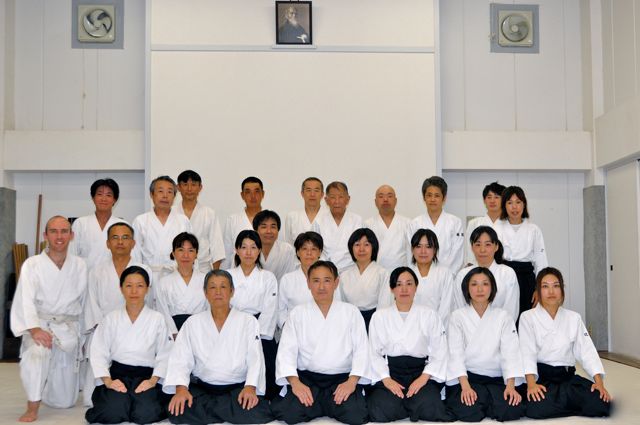
‘Intermediate Gakko graduation August 2010’
Course Overview
Intermediate Gakko, or “Intermediate Academy” (合気道学校 中級課程) is open to anyone holding 3rd Kyuu or 2nd Kyuu. You do not need to have taken the Beginners level, but you must sign up before the course begins and places are limited. The course runs in two 5-month semesters per year, April-August and October-February. There are two 90-minute classes a week, Wednesday and Saturday evenings. At the end of the semester students who have attended at least 2/3 of the classes are eligible to take a grading test (up to 1st Kyuu). The classes are taught entirely in Japanese. More information about “Aikido Gakko” is covered on the Aikiaki web site, in English and in Japanese.
A big challenge
After a brief welcome speech by the Doshu, Ueshiba Moriteru, in which he welcomed us to the course and encouraged us to attend as many classes as possible, it was straight into training.
Intermediate Gakko was a big jump up in difficulty from Beginners Gakko. The classes in the beginners level started slowly, and progressed at a steady pace, and even by the end of a full year were limited to a fairly small set of techniques. Intermediate level, on the other hand, felt like being thrown in the deep end. Right from the start of the course each lesson consisted of a large number of techniques, many of which were new to me. There seemed to be an endless stream of new techniques, even after more than a month into the course. By the end of each lesson it was often hard to remember what techniques we had just been doing, as all the techniques tended to blend into one big jumble. In one extreme case Yokota Sensei covered 15 techniques in 90 minutes, which made for a very challenging lesson! Frankly this was quite overwhelming at first, and I often felt it would have been better if we could have covered fewer techniques and given each one a bit more time to sink in.
One thing I did realise quickly was that each class had a “theme”. I can distinctly remember one of our first classes with Yokota Sensei where the entire class was based on Yokomen Uchi (横面打ち – strike to the side of the head) coupled with a dizzying array of techniques – Shihonage, Iriminage, Kotegaeshi, Ikkyo, Nikkyo, Sankyo, Yonkyo. At that point I had no idea most of those combinations existed, as we had only been taught Yokomen Uchi Shihonage in Beginners Gakko. On the other hand, I remember one of Toriumi Sensei’s classes that seemed to be based around “Kokyu Nage” (呼吸投げ – breath power throw) from a variety of different “attacks” (Katatedori, Ryoutedori, Morotedori, etc). Once you get used to it, this makes a lot of sense, and seems to be normal for most classes at Hombu Dojo.
I can’t remember when it was exactly, but at some stage during my first semester it finally dawned on me that, irrespective of the technique, each of the attacks is generally “dealt with” in a few distinct ways, and that almost any of the attacks can be combined with any of the pins or throws as long as you can make the “transition” between the start of the technique and the end. After that realisation the seemingly endless stream of techniques became a lot less daunting (even if they were still very hard to perform), and the classes made more sense to me.
Gradually the techniques became more familiar, the classes less confusing, and after a while I was finding the Intermediate classes very enjoyable.
Teachers
Once again I can’t talk about the Gakko without special thanks to the teachers. My teachers for Intermediate level were Toriumi Sensei 7th Dan (鳥海先生 七段) on Saturdays, and Yokota Sensei 7th Dan (横田先生 七段) on Wednesdays, with Sasaki Sensei 5th Dan (佐々木先生 五段) taking classes when the other teachers were away.
I’d heard rumours before starting the course that the teachers were very strict, and this was confirmed in the very first class when a couple of the second-time students were chided for their poor ukemi! In fact this was largely in jest, and I soon came to find that the teachers are not overly strict, and even shared a joke or two at times (of course if you were to do anything disrespectful or dangerous the scolding would not be a joke). The teachers were always more than willing to provide correction, and answer any questions regarding techniques (my poor Japanese speaking ability makes it hard for me to ask questions, but the teachers were always happy to answer other students questions).
Toriumi Sensei is usually quite serious, and teaches a lot of suwariwaza (techniques from a sitting position), which he’s very adept at. He included a lot of these on the grading tests at the end of the semester, much to my chagrin.
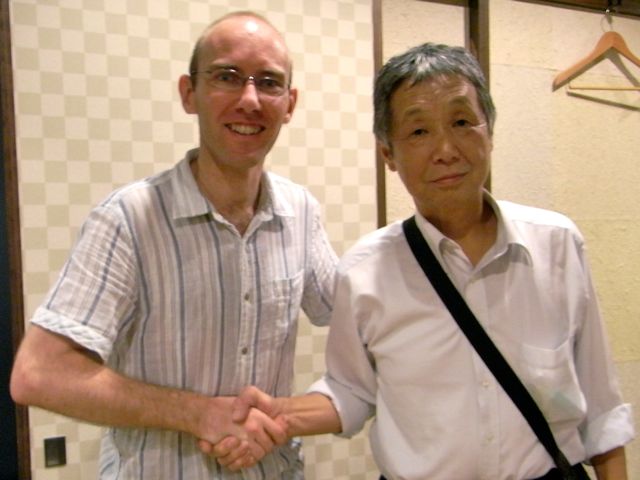
‘Me with Toriumi Sensei’
Yokota Sensei often talked about the use of the sword, which he studies. He demonstrates an amazing number of variations of the techniques, including some unusual examples – in one case his “pin” consisted of pinning my arms behind my back and sitting on me, which got a lot of laughs from the other students.

‘Me with Yokota Sensei’
Sasaki Sensei also taught some great classes that focused on timing and ma-ai (spacing), and I also appreciated his talks about how you should experiment with your techniques rather than just copy the teacher, and he explained that Aikido is different for each person and with each partner.
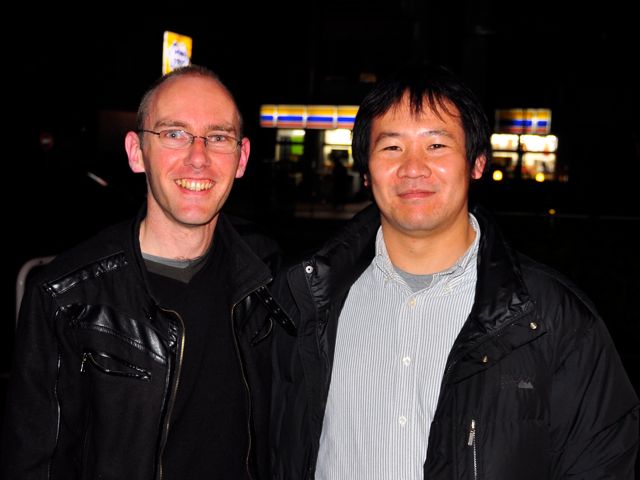
‘Me with Sasaki Sensei’
The teachers have a wealth of experience and knowledge, and it was an amazing opportunity to learn from them. I hope I have retained at least some of what they tried to pass on.
Round and round we go
At the beginning of the course Yokota Sensei began teaching us mae-ukemi (前受け身 – forward rolls). He demonstrated his distinctive style of forward roll, which is a very high forward leap followed by a very graceful landing. At that time I was reasonably comfortable doing forward rolls after having been given some pointers by a helpful sempai in beginners class and spending some time practicing, but the “Yokota-style” rolls were something completely beyond me. Thankfully he then began teaching the rolls in a very accessible manner, starting from a kneeling position, with lots of helpful pointers. Many of the students in our class were obviously “roll virgins” and extremely reluctant, even from a kneeling position. Intermediate Gakko is a good place to learn the forward roll. Yokota Sensei showed tremendous understanding and patience during the course, letting people advance at their own pace. It’s a credit to his teaching that by the end of the course many of those people were performing very smooth rolls from standing with little hesitation.
More daunting than the forward roll, at least for me, was the back-ward roll, which I had not really practiced before. As with the forward roll, “Yokota-style” rolls are very impressive. He demonstrated a roll from a standing position, throwing himself down and “catapulting” himself back onto his feet. Thankfully once again he started instructing us on how to perform the roll from a kneeling position, at slow pace, providing lots of pointers. At first I found it difficult to remember which foot should go over which shoulder, but after a while I realised that it’s just a forward roll in reverse, and after a few attempts I got the basic hang of it.
I spent some time after the classes practicing the rolls, and after a few weeks of trial and (sometimes quite painful) error, I got to the stage where I could perform a poor imitation of the “Yokota-style” forward roll, and even the standing backward roll ending on my feet. My forward roll improved quite a lot, I can now roll “straight” (i.e. where I intend to roll – many people aim for one spot and end up somewhere else!) and it gave me quite a bit more confidence.
Old Friends, New Friends
One of the best things about my time in Beginners Gakko was making friends with my classmates. Some of my friends were still doing their second semester of Beginners level, and a few others couldn’t join Intermediate Gakko because of the classes on Saturday evenings (5:30pm-7:00pm), but quite a few of my friends did join Intermediate level. For many of the women joining Intermediate Gakko it meant their first time wearing a hakama (袴 – dark pleated pants). At Hombu Dojo women are encouraged to wear a hakama from 3rd Kyuu, whereas men only wear them from Shodan (初段 – 1st black belt). Seeing my friends wearing hakama for the first time was great, it seemed to suit all the girls well and they seemed a bit more imposing. I think they were a bit self-conscious, as I would be, but I have to admit I felt a bit jealous!
There were also some new people joining at the Intermediate level, which meant new friends. Three new girls from another Dojo in Chofu joined the class. I noticed that their technique was different (in a good way) the first time I trained with them. I wasn’t surprised to find out they had been training for a number of years at their local Dojo, compared to 12-18 months for most of us. They had not had the opportunity to take gradings at their home Dojo, so their official grade of 3rd Kyuu didn’t reflect their level of experience.
Another notable new classmate was Don (he insisted everyone call him that, most people use their surnames). Don was the oldest student in the class by quite a margin, and announced during the semester that he had just celebrated his 80th birthday! Training with Don meant taking extra care, as he was understandably a bit more fragile than us youngsters. He had a particular difficulty with mae-ukemi, but he showed remarkable tenacity. Don eventually stopped going to the school classes during our second semester, but only because he was training every day in the regular classes and was the first amongst our level to pass the 1st Kyuu grading!
The opportunity to meet so many great people and make friends has been just as important as the chance to learn Aikido from the fantastic teachers.
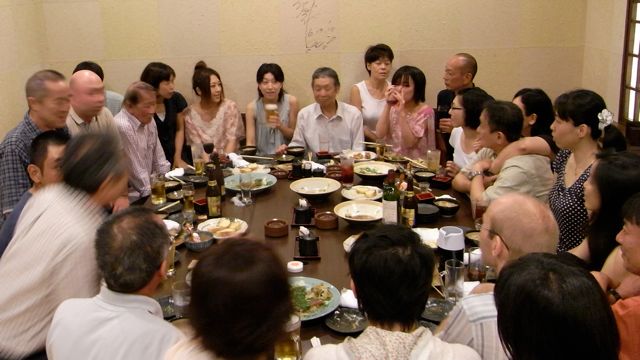
‘Intermediate Gakko end-of-semester dinner.’
Listen very carefully
Just like in Beginners Gakko, the teachers provide a lot of explanation during the classes, significantly more than the regular classes. Thankfully my Japanese listening had improved quite a lot during the previous year, especially with regards to Aikido terminology. There were still many times where I didn’t understand the subtleties (or sometimes the main point) of what they were saying, but those times are becoming less frequent. I found I was usually able to watch how the teacher was moving while still listening to their explanations, and then really work on improving my techniques in the area the teacher was talking about.
For foreign students thinking of taking Intermediate Gakko, I think not knowing Japanese would be a big disadvantage. The techniques should be roughly familiar at this level, and a lot of value can be gained by watching and feeling what the teacher is doing, but it would be a shame to miss out on the explanations the teachers are giving, as they will often be trying to direct your attention to a specific concept, and it does give a lot of insight into their views on Aikido.
Jiyu Waza
Once again the semester passed much quicker than I realised, and it was soon time to prepare for my 2nd Kyuu grading. This was my first grading where I would be required to perform “Jiyu Waza” (自由技 – free technique). In Jiyu Waza you are required to perform a continuous series of techniques from the same “attack” – in my case katatedori (片手取り – one hand held). We were told we must be able to perform 7-10 distinct techniques, and techniques were not to be repeated. This sounds simple, but upon trying it I found that it is very easy to get “stuck” thinking about what technique to do, and freeze up. It took quite a few practice sessions before I managed to avoid freezing up while thinking of my next technique.
Thankfully I got a tip from Kikkawa San, a sempai I’d met in beginner classes around the time I started, that I should decide on an order of the techniques ahead of time, and he suggested using alphabetical order. This seemed a little bit like cheating, but it helped a lot to get started. After a while I found myself relying less on the order, although it’s hard to avoid repeating techniques unless you keep track carefully.
The other aspect of Jiyu Waza, that wasn’t really explicitly required for the test, but I tried to incorporate into my practice, was to move from a series of single “static” techniques, to a more “flowing” series of techniques. That is, rather than waiting until my partner has grabbed my hand, start the technique as they go to grab. This requires you to work on your timing and distance a lot, which makes it hard but very worthwhile. Jiyu Waza is still not easy for me, but I improved a lot from the practice.
Third floor classes
It was towards the end of the semester that I finally had the courage to try out the “Regular” classes on the 3rd floor. I didn’t really know what to expect, so it was quite daunting. I attended a couple of Seki Sensei’s classes, which turned out to be a good choice as he generally concentrates on techniques that someone around 2nd or 3rd Kyuu will know. You don’t change partners in Seki Sensei’s classes, so you can train for the whole class with someone you know, or if you train with someone new it gives you more of a chance to get used to your partner. The classes were difficult, but very worthwhile.
Testing time again
As the test got nearer everyone seemed to be getting more serious, with most people staying around after class to get in a bit of extra practice. The week before the test we did a full dress-rehearsal of the test. A couple of people were obviously struggling to remember some of the techniques, and Toriumi Sensei was quite strict and made them repeat the techniques until he was satisfied.
I’d been expecting to take the test with Kuboyama San, one of my friends in the class, and we had spent quite a bit of time paired up for the Jiyu-Waza practice sessions. Unfortunately when the pairs for the test were called, I was partnered with another student with whom I had not really trained much, and Kuboyama San had been left out! Thankfully Kuboyama San got to do his test in the end, and my test went okay as well. The people who’d struggled the week before had improved noticeably, and everyone passed the test.
The following week we received our certificates for attendance and our new Kyuu gradings from the Doshu. He gave a quick speech congratulating us, and encouraging us to continue with our training. This was followed by dinner with the teachers and students.
I was lucky enough to listen to some of Yokota Sensei’s stories about him being sent around the world. He talked about going to China to visit some monks that practice Kung-Fu. They were determined to test him out, and he was suddenly faced with a monk making a flying kick to his head! Apparenlty Ikkyo can be quite effective against kicks! On another occasion somewhere in Eastern Europe he had to demonstrate on a cobble-stone courtyard – too bad for his uke! Sasaki Sensei talked to me about how he had lived in Papua New Guinea for a few years, teaching the local police force. These teachers were literally responsible for the spread of Aikido around the world, and it was an amazing experience to be able to talk to them.

‘Yokota Sensei and Toriumi Sensei’
Second Time Around
I was very keen to attend Intermediate Gakko for a second semester, and signed up as soon as possible. The second time through the course was not as overwhelming as the first, although the classes were still very challenging and I felt I had a lot to learn. My friends who had just completed their second semester of Beginners level had now joined our class, and training with them again was a lot of fun. Being one of the senior students, I also got to take quite a lot of ukemi, particularly from Yokota Sensei, which was a fantastic experience. Yokota Sensei also called on Nakano San a lot as uke, which is slightly unusual as mostly the teachers call on the males, but that’s understandable as her ukemi was undoubtedly the best in the class and great to watch.
Tobi Ukemi
While the Intermediate course covers mae-ukemi, it does not generally cover tobi-ukemi (飛び受け身 – break-falls). However, at one point during my second semester, Yokota Sensei started talking about tobi-ukemi, and even started to demonstrate it with a few people. I think some of the students had asked him about it during the dinner at the start of semester. I was lucky enough to be one of those people. Instead of our normal ukemi from kotegaeshi, he told me I should do a forward roll. The first time he let go, and I did the roll. The second time he didn’t let go, and with a quick flick, I made my first break-fall. It was surprisingly easy and painless, given the loud slapping noise as my legs hit the floor. A couple of other students were also lucky enough to get a go (or rather be demonstrated on). Later in the class it was Tsujikawa San’s turn, but unfortunately she landed awkwardly (through no fault of Yokota Sensei). She ended up with a badly sprained knee, requiring crutches, and could only watch the lessons for the next 8 weeks or so. Thankfully Tsujikawa San recovered, and was able to rejoin the training, and take the test at the end of the semester. Unfortunately that was the end of our instruction in tobi-ukemi, and I doubt Yokota Sensei will teach it during Intermediate Gakko again.
Back to the 3rd floor
In April I finally decided it was time to start taking one or two 3rd floor classes a week. The classes were definitely hard, but I think the Intermediate level classes helped a lot. After warm-up there’s a scramble to find a partner, and I couldn’t help feeling that most of the black-belts didn’t really want to get stuck with a white-belt, but that being said, my partners were always very helpful and patient. For beginners it can be a good idea to go with someone you know for the first few times, especially if you can make it to one of the classes where you don’t swap partners (e.g. Seki Sensei’s classes).
Embukai
In May our class participated in the 48th All Japan Aikido Demonstration, which was a lot of fun.
Weak in the knees
Around the second week of June I hit my first big road-block in training. It still isn’t clear to me exactly what happened, but I believe I put too much pressure on my knees during stretching, and the day after a walk up Takao-San I found I had a sharp pain when bearing weight on my left knee (my right knee was affected to a lesser extent). I stopped training, sitting in on one of the Intermediate classes without participating. The next few weeks I only attended the Intermediate classes, and at first I was only training very slowly. The teachers were very understanding, and I was allowed to avoid the seated techniques which were too hard on my knees. My biggest fear was that I wouldn’t recover in time for the test at the end of August, but thankfully I was able to ease back into training and started taking extra beginner classes again about mid-July. I had just a taste of what it must have been like for Tsujikawa San, who was out of action for over a month. It must have been much harder for her, but she came to every class to observe, and she showed remarkable spirit. She was also able to resume training with enough time to prepare for the test.
Finishing Up
It was testing time again, and this time my Jiyu Waza would be Morotedori (諸手取り – the attacker using both hands to hold one arm). Thankfully I’d had a really good class on the 3rd floor earlier in the year, in which I got to train with one of the uchi-deshi, and that had given me the basics I needed. Plenty of practice during class in the weeks leading up to the test helped a lot too, so I wasn’t feeling completely out of my depth by the time the test came around.
A couple of people struggled on the test, mostly due to lack of practice time. For those people only taking the school classes, the tests are going to be very hard. There are only about 35 lessons in the semester before the test, which is significantly less than the normal requirements, 50 for 2nd Kyuu and 60 for 1st Kyuu, which is really not enough. I’d thoroughly recommend attending extra classes, which most people are quite keen on doing.
In the end everyone passed the test.
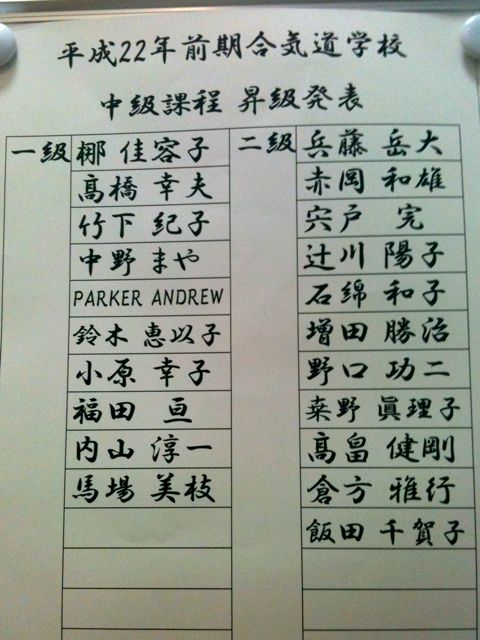
‘1st Kyuu, Intermediate Gakko August 2010’
We had our final ceremony, receiving our new Kyuu certificates, and had a dinner with the teachers after our last lesson. I was able to talk to my friends quite a bit, at least until it came time for each of us to give a short speech, and then my Japanese ability quickly disappeared. Yokota Sensei even offered to translate for me. Toriumi Sensei encouraged me to speak Japanese, which Yokota Sensei then translated into English, getting a few laughs.
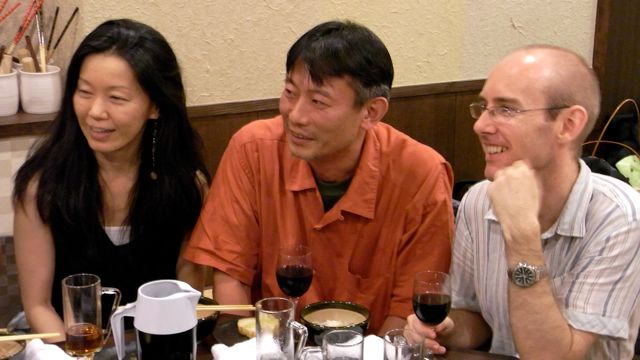
‘End of semester drinks’
Getting Serious
A lot of my friends from the Intermediate class seem to be just as obsessed with Aikido as myself. I’ve been getting steadily more serious about Aikido, and as I wrote in Time on the mat, I’d been keeping track of my training times since the beginning of the year. I’d worked up to training 4-5 times a week for April and May, and only reduced my training due to injury. By the end of my second semester I was regularly running into them in the other classes on the second floor, and the 3rd floor as well.
At the end of the semester Yokota Sensei asked for an indication who would be continuing on. I think almost all of the students who had just passed 2nd Kyuu said they would be repeating Intermediate level, and of the 14 students who had passed 1st Kyuu, 12 indicated they would be going on to the “Advanced Gakko”. Everyone seemed keen to continue training, whether it be through the Gakko or via other classes.
Final thoughts
Things to consider
The things to consider about taking Intermediate Gakko are largely the same as those for Beginners Gakko.
The fixed schedule may be hard for some people. Classes early on a Saturday evening can be especially hard for some people due to work, but for others like myself it is actually a good day for training.
The 4th floor dojo is quite small, and with 25 or so people it can get quite crowded. It’s a shame the course can’t be held in one of the bigger dojos, which would give people the chance to take ukemi a bit more freely. But most of the other classes at Hombu Dojo are even more cramped, especially the “regular” classes on the third floor, so it’s not really a disadvantage.
The cost of the course is 63,000円, which is a significant amount, but this is an amazing opportunity to learn from the incredible teachers. I’d thoroughly recommend taking extra classes, so don’t forget to allow extra for that. If your budget allows it’s well worth it.
A reasonable understanding of Japanese is required to get the most out of the course, as the teachers generally explain more than the normal classes.
Overall
The learning curve of Intermediate Gakko is steep, but it does provide a good transition from beginners classes (both those on the 2nd floor and Beginners Gakko), to the regular 3rd floor classes at Hombu Dojo and it’s a good way to improve.
My time in the Intermediate Gakko was a fantastic experience, and I enjoyed it tremendously. I have made some great friends, I’ve had the opportunity to train under some great teachers, and I’ve had a lot of fun.
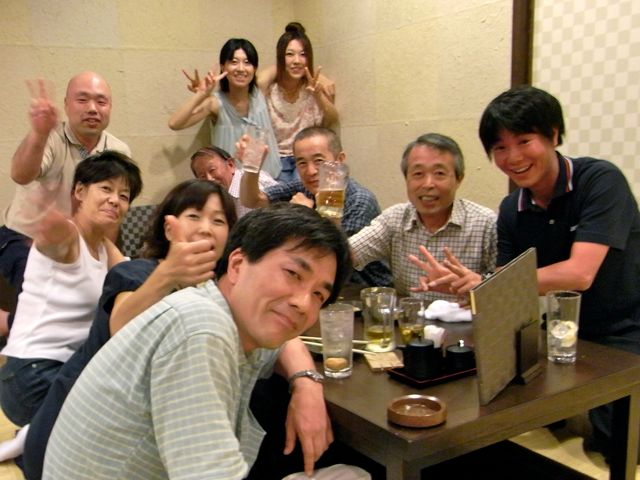
‘Friends from Intermediate Gakko’